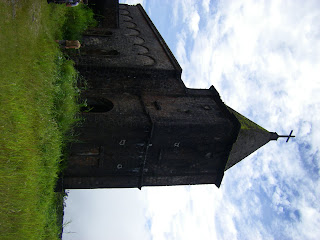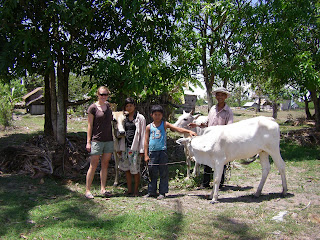This was an intriguing week because I finished up with my English teaching, as well as got to travel to the rural Prey Veng province to see where my students are from. Teaching English to university students had its challenges, but was ultimately a completely rewarding experience that was cemented after seeing firsthand how important education really is to all my students. The challenges I had sprouted from my lack of materials and planning resources- I came to Cambodia without any knowledge of what age or level of English learners I would be teaching, so therefore limited my stash of teaching "stuff" to a few reference books, two whiteboard markers, notecards, and a working memory of the content I learned from my Teaching English as a Foreign Language on-line course. In the end it was easy because I merely planned my instruction to fit the needs of my students based on informal assessments from their writing and speaking skills during previous lessons. I would make notes on what aspects of pronunciation, grammar, and vocabulary needed work, and then pick a focus from each for the following lesson. I found that games and candy also work wonders no matter the age of the student!
I have to give all of the credit for what I deem as a "successful" teaching experience to my students. I was nervous as to how I would be received as their teacher, seeing that I was only two years older than most of them and I had no prior experience! After taking a visit to their former high school in rural Prey Veng with the directors of the Chances for Cambodia Program, I soon realized the reasons behind my students' amazingly high regard toward their education. At 5:00 a.m. on Thursday, I set off with the three directors of the program as well as an English woman named Rose who is taking my place as the English teacher for a day trip that has made me further appreciate the power of education.
The purpose for the trek to Prey Veng, which is considered to be the poorest province in Cambodia, was to see the school (grades 6-12) that that the Chances for Cambodia program uses to select students for potential university scholarship programs. The school was founded and built in 2000 by a remarkable man named Kong Vorn, or "Mr. Kong," who is one of the directors of the program that I worked under. Through a captivating conversation with him on the three-hour bumpy van ride, I learned that Mr. Kong was a Japanese journalist living in Phnom Penh during the Khmer Rouge invasion in 1975. After being captured by soldiers and being faced with the prospect of imminent death, Mr. Kong miraculously escaped by kicking a guard and running deep into the jungle, managing to survive the four years of Pol Pot terror. After living for several years successfully back in Japan, Mr. Kong returned to Prey Veng, the homeland of his Cambodian wife, with the most admirable mission: to use education as a tool to prevent such atrocities from happening in the future.
I felt so honored to be in the presence of a person who had overcome so many obstacles to provide a free education for students who might otherwise not have the chance. I was transfixed by the scene outside the van window as we jolted along several miles of winding dirt road deeper and deeper into the province. Like scenes from a movie, images of old thatched-roof huts on leaning stilts that threatened to fall over on their shirtless inhabitants flashed by. The signs of poverty became more evident as I saw children working in the rice fields with the most bony of cattle being used to plow nearby. It was the closest to backwards time travel I think I will ever encounter.
We arrived at the school at about 8:00. Amidst the poor surroundings, the school is a welcoming structure that can truly be said to be the lone gem that shines a light on the poverty that encompasses it. Over 850 students attend, all dressed sharply in uniforms with blue button-up tops and black pants or skirts. Mr. Kong beamed as we were greeted by the school principal and staff. While listening to Mr. Kong during a tour of the grounds, I learned that the school had only just received access to electricity this year and has just two computers to its name. Students have to perform highly on entrance exams to be selected to attend, so it truly services the best and brightest children in the area. The teachers at the school are also of greatest quality in Cambodia and are paid some of the highest teacher salaries in the region- about 175 dollars a month. We had the pleasure of sitting in on two of the schools'English classes, one of which was taught by a Peace Corps volunteer named Norman. The students all stood in unison and greeted us as we entered, all vying to ask us questions in English to proudly demonstrate their knowledge of the language.
At 10:30, an assembly was held in the school library with all of the high-school seniors (called "year-12"students). Unexpectedly, my travel companions and I were lead to the front of the room and were seated like royalty at a large table facing the crowd. Following a speech by Mr. Kong about the importance of the students' performance on the upcoming year-end exams as selection criteria for the scholarships, we were all expected to address the crowd with the help of the translation of the other Khmer English teacher. In my under dressed outfit of a t-shirt, shorts, and flip flops, I did my best to deliver an on-the-fly explanation of my role as an English teacher of graduates from their school and to express how honored I felt to be so welcomed as a guest visitor. The powerful energy that surged through the crowd after each of our speeches further showed me the respect that these students had for their teachers, Mr. Kong, and anyone working to further their education.
My visit to the school was topped off with the serving of delicious traditional Khmer lunch. The most enjoyable part about the trip was listening to Mr. Kong talk about his vision and reasons behind building the school. He receives a pension from Japan, but lives very modestly as he gives everything he has towards the betterment of the school. One key phrase stood out to me that he stated multiple times during our discussion: "I work not for money. I work for my people." Listening to this man, who at the age of 70 still works tirelessly for the sake of his people, made me wonder: what would the world be like with more people like Mr. Kong? The opportunities that he has provided for so many Cambodian students have created such an impact; the most visible effect is the deep appreciation that all of the students here hold for their own education.
Sorry for making this so long- it is difficult to convey the experience and do it justice in so few words! The Phnom Penh Post just recently published a great article featuring Mr. Kong. You can access it at http://www.phnompenhpost.com/index.php/2010053139381/National-news/reunion-triggers-painful-emotions-over-35-years-on.html
or by googling Phnom Penh Post + Kong Vorn. It should be the second result.
On Monday I am off to the Thai border for a night and then I will be in Siem Reap the rest of the week to visit the temples of Angkor. Should have an interesting update this coming weekend!














